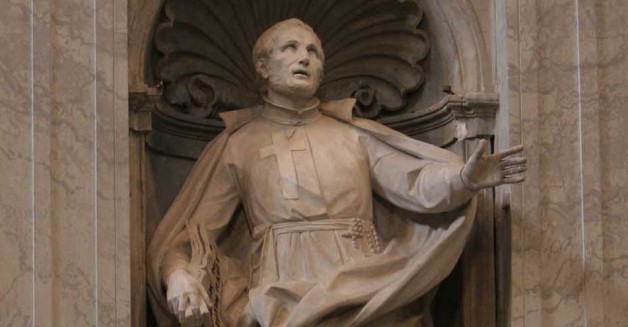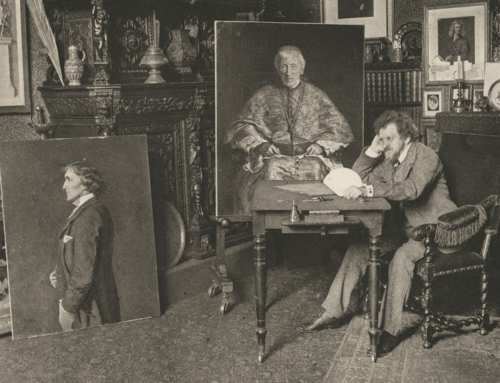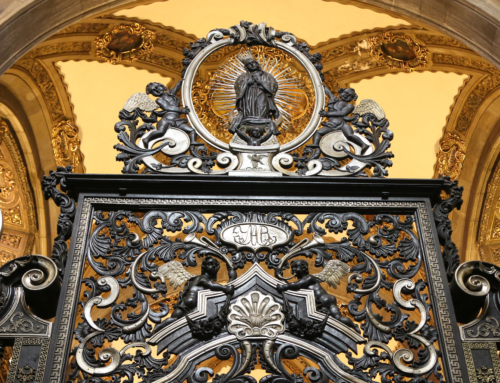In 1551 Saint Ignatius founded the Roman College, “a school of grammar, humanity, and Christian doctrine.” By the 1580s, this predecessor of today’s Gregorian University boasted some very illustrious professors—Suárez, Vásquez, and Saint Robert Bellarmine—as well as one very unusual student. At thirty-two, he was as old as some of his teachers, and, at six-and-a-half feet tall, he towered over nearly all his contemporaries, especially the thirteen-year-old boys with whom he attended Latin class. They would laugh at their gigantic, bearded classmate and say, Venisti tarde! “You’ve come late!” Of course, if they had known their friend had once been a battle-hardened soldier with a violent temper, they might have spoken more respectfully. As it was, they just got an affectionate smile.
Saint Camillus de Lellis was born on May 25, 1550 in Bucchianico, Italy. As to Latin, so to the world he came late: his mother, Camilla, was almost sixty at the time. She and her husband, Giovanni, who was of noble ancestry, had waited in vain for an heir—their only other son had died in childbirth—so when the midwife delivered a healthy baby boy, Giovanni positively leapt for joy, capering about the room. Camilla, always the sensible one, simply smiled and told her excitable spouse to act his age. A good Italian, he only gamboled the more, asking her how she could be so calm “seeing that we have such a big son we could send him to school this very day!”
In what seems to have been a unique departure from family tradition, Camillus was named after his mother, but in every other way he took after his father, the hot-blooded career soldier. Camilla, who died when her son was only thirteen, could do nothing to keep him in line, and Giovanni was too often away from home, on campaign, to do so. The boy repeatedly ran away from school. A tutor was hired, but could not manage him. Card playing and gambling became his passion and, eventually, an addiction. He was intelligent—known for his ability to recite long poems from memory—but undisciplined and reckless. Finally, at seventeen, he went off to fight against the Turks. His father, even in his old age, could not resist coming along.
As it happened, both father and son got sick on the way. Giovanni became gravely ill, received the last sacraments, and died. Camillus was left destitute, and, possibly as a result of his illness, a sore broke out on his right foot. Festering, it never healed, and became a painful, lifelong affliction.
And so he began his unhappy journey home. On the way, he chanced to meet two Franciscan friars, and, admiring their apparent serenity and good cheer, he secretly, and perhaps rashly, vowed to become a friar himself. Going to see his uncle, who was superior of a Franciscan house in Aquila, he sought admittance to the community. The wise old man encouraged him, but said he was not yet ready to enter religious life.
After a period of convalescence at the hospital of San Giacomo in Rome, where he was hired as a servant and then fired for constant quarrelling and gambling, Camillus reenlisted and fought in the bitter assault on the Turkish fortress of Barbagno (on the coast of modern-day Montenegro). Returning with his pay, he immediately gambled it away, along with his cloak. So he went back to war. On a sea voyage to Naples, a storm almost took his life. This inspired him to renew his vow to become a Franciscan, but, having arrived at Naples, he once again gambled everything away, including the very shirt on his back. Reduced to utter poverty, he wandered about with a fellow soldier, Tiberio, and begged for food.
It was in this sorry state that he caught the attention of a certain Antonio di Nicastro, who offered him a job working for the Capuchins. At first, Camillus declined, perhaps because the prospect of doing manual labor was too much for his pride. Eventually, however, he reconsidered the offer, thinking this might be God’s way of allowing him to make good on his vow. But after several weeks on the job, he was so desperate to get back to his old life that he refused to wear some of the friars’ serge, offered as protection against the cold, because it was too much like donning the habit.
Maybe this was protesting too much, because soon afterward the decisive moment came.
The Capuchins sent Camillus to fetch wine from a nearby friary. The superior there took him aside and, beneath a grape arbor, spoke to him about God. He exhorted him, when tempted by evil thoughts, to “spit in the face of the devil.” Perhaps this roused the soldier’s combative spirit; certainly, the conversation roused his conscience. The next day, riding back on a mule with his cargo of wine, he could stand it no longer. He flung himself to the road and wept freely for all his sins.
Camillus never became a Franciscan. (It wasn’t for lack of trying.) He went to Rome and worked in the very hospital from which, years before, he’d been expelled for gambling. Saint Philip Neri became his spiritual director, and he went on to found his own religious order, dedicated to caring for the sick. That meant he had to become a priest, and becoming a priest meant—yes—learning Latin.
Saint Camillus, pray for us!
✠
Image: St. Camillus de Lellis, St. Peter’s Basilica. (The book in Saint Camillus’s right hand displays John 15:13: “No man has greater love than this, that he lay down his life for his friends.” It’s a fitting verse since, from the time of their founding, the Camillians have taken a fourth vow: to minister to the sick even at risk to their own lives. Indeed, during Saint Camillus’s own lifetime, several of his followers died as a direct result of caring for victims of the Plague. The distinctive red cross on their habit, along with their history of serving those afflicted by war, famine, and epidemic, has led some to call the Camillians “the original Red Cross.”)








